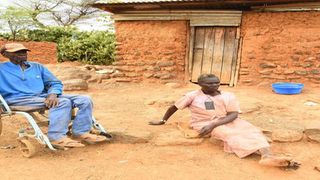
Mr William Ewoi and his wife Esther, who were crippled by Lake Baringo’s fluoride waters, at their home in Kampi ya Samaki, Baringo County.
| Cheboite Kigen | Nation Media GroupBaringo
Premium
Villagers crippled by Lake Baringo’s poisonous waters
What you need to know:
- A group of women crippled by the condition now crush rocks into ballast on the shores of the lake.
- While men and children have also been affected, women are the hardest hit.
For years, Esther Ewoi, 51, thought evil spirits were tormenting her family. This is the only explanation she had for the condition she and her husband William Ewoi, 55, suffered from.
Over the years, their bones bent so badly that they could not wash, eat, or leave their house without help.
When the Nation visited her home in Kampi Samaki village on the shores of Lake Baringo, Ewoi was resting under a tree in the company of her grandchildren. “My legs first became weak about 30 years ago,” the mother of six recalled.
She then developed stiffness and pain in her neck, back and joints.
“At first I thought it was a normal sickness, but the pain worsened and [eventually] left me paralysed,” she said.
At Kampi ya Samaki Dispensary, which has since been swallowed by the rising waters of the lake, health workers told her that her bones weakened after drinking water with high fluoride content.
Today, Ewoi is crippled and confined to her home because she could not afford specialised treatment.
“I used to do many things on my own to eke out a living for my family. But things have changed. Life is hard because my husband suffered the same fate. I can’t walk, and can only use my hands to crawl,” she told the Nation.
Her husband uses a wheelchair to move around the home.
“I used to work at the Lake Baringo Snake Park, but I started developing the problem years back. My legs became weak, and I could not walk. So I had to resign,” he said.
For more than 50 years, the two have been drinking water from Lake Baringo, not knowing they were slowly taking poison.
At the nearby Lesanao village, Mary Kiptosok uses crutches to move around. Her husband died more than 10 years ago.
The mother of five said she could not fend for her family after her bones weakened.

Mary Kiptosok who was crippled by Lake Baringo's fluoride waters narrates her story at Kampi ya Samaki Baringo County on January 11,2021.
Weak-bone condition
“I realised I had the problem in 2015. I now depend on well-wishers to feed my family. Three of my children are still in school,” she said, adding, donors assist them.
Soti Cheburet, 70, from Forest Area, is another victim. She was diagnosed with skeletal fluorosis by doctors in Gilgil.
Several other villagers have developed the weak-bone condition, which doctors have linked to the dangerously high fluoride levels in the lake water.
“We’ve no option. We still drink from the lake because it is our only source of water,” James Kiptosok, another resident said.
A group of women crippled by the condition now crush rocks into ballast on the shores of the lake, selling a bucket at Sh50. It is among the few jobs they can do since it requires little mobility.
While men and children have also been affected, women are the hardest hit. Besides Kampi Samaki, the skeletal disease has ravaged several villages including Ng’enyin, Forest, Noosukro, Ng’ambo, Loruk, Ruko, Kiserian, Kokwo Island and Kapkirwok.
The victims say no help has so far come from the county and national governments.
“Officials from Baringo government visited once and took a list of the victims, but no help has come through. We see several researchers around here, but all they do is come, study and leave,” said Vitalis Onyango, an elder.
Ilchamus MCA Joseph Leparsalach estimated that, up to 5,000 people in 10 villages have been affected by skeletal and dental fluorosis. They include children who have developed bow legs.
“Taking water with excess fluoride makes bones weak and brittle due to lack of calcium. This predisposes people to upper and lower limb fractures and back and neck pains. S
Skeletal fluorosis affects people with a severe case of fluorosis. Their bones are weak and may fracture easily,” said Dr John Ombati, an orthopaedic expert.
A University of Nairobi Geology Department study attributed the high levels of fluoride to emissions from volcanic activity in the East African Rift System.





